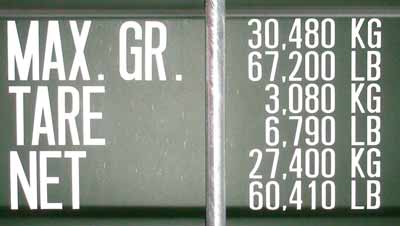
Containerization


During the 1960's and 70's it was realised that this new industry must be standardised by the ISO for it to be safe and reliable.
In 1972 the Container Safety Convention (CSC) mandated the requirement of attaching an Internationally recognised Safety Approval Plate to all shipping containers enabling their smooth throughput at transfer points. A fascinating comprehensive history of intermodal freight transport with specfic reference to ISO containers is given at
The terms Cargo Transport Units (CTU's) and Freight Units (FU's) are general terms used throughout this site to describe other units, not just containers, that can be handled by conventional container handling equipment.

Inland container terminal on the Rhine
ISO Standardization of Cargo Transport Units CTU's
ISO standards nowadays are normally rigorously adehered to and are constantly being updated, however containers manufactured to previous standards are still around and regulations to which they complied with are mentioned here for historical interest only.
The first major publication was ISO-668 in 1968, this covered:- Terminology, dimensions and ratings. Internal dimension were given in ISO-1897 (Withdrawn) for standard ISO units. (Variants were manufactured with an internal width of 8ft specifically for loading standard 8ft wide pallets with forklift trucks. These required non standard corner fittings and special lifting lugs to handle them.

External height ranges for A,B,C,D & E containers.
Maximum Gross Weight (MGW)
 This information should be prominantly displayed on containers.
This information should be prominantly displayed on containers.

Container Safety Convention (CSC)

An up to date Safety Approval Plate is essential for containers used in international trade and identification plate must be displayed in a prominant place, safe from being damaged. It acts as an international passport, guaranteeing the security of their contents besides being fit for purpose.Information appertaining to strength capacity of the container presented on the plate is covered in great detail in Amendments to the International Convention for Safe Containers of 2 December 1972
Perhaps the most comprehensive source of information for both Cargo Transport Units and CSC plating is available on the GDV link below. Over 17 million containers have accumulated around the world since their introduction, many of which may not be up to date nor even standard, but they may need shifting and when called upon to handle them and there are problems with identification, it would be wise to consult the
Main Transport Unit Types
Standard Series1 Containers
 Universal dry cargo containers
Universal dry cargo containers
Gauge Standard Applies to the space envelope defined by the Standard Series1 Container volumes and any cargo that extends beyond their limits is classified as Out of Gauge (OOG).
Nowadays the height is more usually 8ft6in but universally 8ft wide. A variant known as European overland container has an internal width of 8ft making the external width 8ft 6in. Non standard corner fittings are used that allow the the base and top pickup points to correspond to standard ISO dimensions for handling and securing purposes, but standard lifting lugs CANNOT be used in bottom corner fitting apertures with overhanging top flange.
Platforms
 Out Of Gauge Flat
Out Of Gauge Flat
The example opposite of an OOG lift shows a uniformly distributed loaded 40ft platform with both corner and inboard lifting points (corner castings). The inboard points have 30ft centres, resulting with greater lifting angles and, therefore, lower sling forces. These particular early platforms were very flexible and when fully laden this lifting arrangement, using inboard points rather than the corners, was widely practiced. Modern 40 ft types use end lifting points only on account of their increased rigidity.
Standard Platforms
 20ft and 40ft ISO Flats
20ft and 40ft ISO Flats
Flat Racks
 Flatrack High Cube 40ft Platform
Flatrack High Cube 40ft Platform
Tank Containers.
These are generally 20ft long, and can be used to carry liquid, gases, dry powder or granules and are usually rated in Litres. When filled with liquids or solids, tanks may present problems when being lifted because of their mobile centre of gravity. There are three types:-Beam Tank having 27,000 litres capacity for gases only, where the tank acts as a monocoque structure with corner fitting attachments welded to it resulting with low tare weight but limited strength.
Generic Tank. This is by far the most common type where a self contained tank is built into ISO dimensioned rigid frame for maximum protection. Capacity ranges from 17,000 Litres to a maximum of 26,000 Litres but when carrying dry materials Maximum Gross Weight is limited to 33.5ton.
Swap Tanks have an increased capacity of 35,000 Litres and are made for ease of intermodal transfer but being non standard they don't have the same degree of protection as the Generic Tank.
Non-standard Specialised Containment Units.
Not all freight units are ISO Standard Containers, variants have evolved to satisfy the ever changing demands in this industry and many now carry specialised equipment other than freight.The process unit is a self contained water filtration system comprising generator, suction and discharge pumps, to be transported via modified 40ft container lorry. The other unit is used by City of London Council to convey domestic rubbish from riverside depots along the Thames, by barges, to incinerators down river where they are offloaded by standard container handling equipment onto specialised vehicles for the last leg of their journey. These fully sealed reinforced bins have the same base and roof dimensions as a 20ft Series 1C container.
If non-standard types are to be transported across international borders, it is advisable to incorporate pick up points that conform to applicable ISO standards in order that they can be handled with conventional container lifting equipment. Process units such as electricity generators, pumps etc should at least be mounted on a rigid platform type base, fitted with ISO bottom corner fittings at positions given in ISO 668 for standard containers.

40ft Process Unit with 8 standard
ISO bottom corner lifting points.
 20ft Ton Waste Transporter.
20ft Ton Waste Transporter.CX type, height less than 8 ft.

